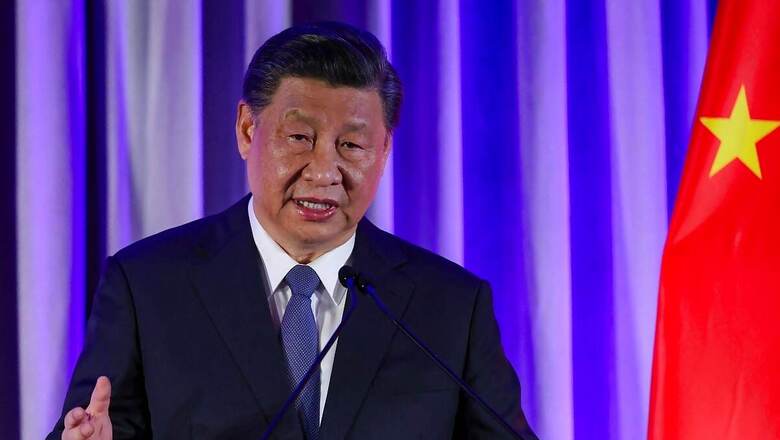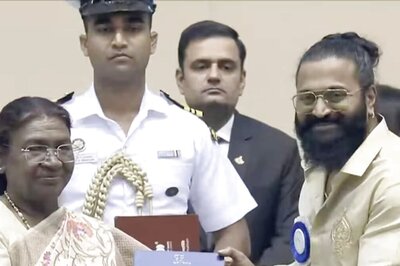
views
In 2015, Chinese President Xi Jinping announced a major transformation of the People’s Liberation Army (PLA) into a lean, mean fighting machine with informationised warfare at the core and the US in the Indo-Pacific as the target.
The number of troops was reduced by 3,00,000 to two million, and the PLA Strategic Support Force (PLASSF) was established to manage psychological, information, space, cyber and electronic warfare. In 2016, Xi reduced the number of PLA Theatre Commands from seven to five for “precise, multi-dimensional, trans-theatre, multi-functional and sustainable operations”.
The PLASSF aimed to prevent stovepipes, which means intelligence sharing without context within a government branch but not with other branches. For example, raw and misleading intel — several from dishonest sources — on Saddam Hussein’s alleged collaboration with al-Qaeda and the fictional WMD programme, was provided to the George W Bush administration before ‘Operation Desert Storm’.
Before the PLASSF was set up, China faced the same problem with no information/intel collaboration between competing government branches.
Now, the PLASSF has been disbanded in the second-most elaborate restructuring. Xi has formed the Information Support Force (PLAISF, the erstwhile Network System Department), the Aerospace Force (PLASF, earlier Space Systems Department) and the Cyberspace Force (PLACF, formerly Network Systems Department). The PLAISF will also be responsible for electronic and psychological warfare.
The PLA now comprises four arms — the three new forces plus the pre-existing Joint Logistics Support Force — and four services, the PLA Ground Force (PLAGF), PLA Navy (PLAN), PLA Air Force (PLAAF) and PLA Rocket Force (PLARF).
According to Xi, the PLAISF, responsible for network formation systems, communications support and network defence, is “a brand-new strategic arm of the PLA and a key underpinning of coordinated development and application of the network information system” that would help China “fight and win in modern warfare.”
Much has been written about the latest restructuring with experts explaining that the new forces will report directly to the Central Military Commission, headed by Xi, who wanted to consolidate his power and assume direct control over the PLA’s strategic capabilities.
Some writers see the latest move as linked to the recent corruption purge in the PLARF while others argue that the PLASSF was unsuitable for the PLA’s needs and had reduced Xi’s visibility of space, cyberspace and network management. For example, Joe Biden claimed last year that Xi was kept in the dark about the Chinese surveillance balloon, which was shot down by the US Air Force.
However, the main reason for the latest revamp is apparently Xi’s disappointment with the lack of speed in the development of intelligentised warfare, wherein artificial intelligence (AI) plays a critical role in an integrated joint operation by the PLAGF, PLAAF, PLAN, PLARF and space and cyber forces.
China realised the significance of AI in future wars way back in 2019. With a focus on the US in the Asia Pacific and “Taiwan independence” separatist forces, the 2019 China Defence White Paper mentioned that America is “engaging in technological and institutional innovation in pursuit of absolute military superiority” in the Asia Pacific.
Mentioning the increasing use of AI, quantum information, big data, cloud computing and the Internet of Things by other powers, the paper read that war is “evolving in form towards informationised warfare, and intelligent warfare is on the horizon” due to the rapid development in high-tech military technologies based on information technology.
From informationised to intelligentised warfare
Before Xi changed the PLA’s doctrine, the Chinese military’s concept of fighting underwent three significant changes.
The first change was introduced by Paramount Leader Deng Xiaoping’s doctrine of fighting “Local War Under Modern Conditions”, emphasising speed, mobility and lethality instead of attrition and protraction.
The second change was introduced by President Jiang Zemin. The doctrine of fighting ‘Local Wars Under Modern High-Tech Conditions’ in 1993 proposed joint operations by multiple PLA branches using command, control, communications, computers, intelligence, surveillance, and reconnaissance (C4ISR) plus firepower and mobility.
The 1991 Gulf War, which involved joint operations under high-technology conditions, made the PLA realise the importance of synergy between all the branches of the armed forces, precision strikes by long-range munitions, and computer network and information dominance.
China also realised the importance of space operations from the Kosovo air campaign, which was planned and executed with the help of classified US satellite images, enabling the B-52s and B-2s to bomb targets with GPS-guided munitions.
In 1999, Jiang changed the concept to ‘Local Wars Under Modern Informationised Conditions’ and added the electromagnetic domain.
The third change was introduced by Hu Jintao in 2003. ‘Local Wars Under The Conditions of Informationisation’ meant joint operations and an information system-based system of systems operational capability. It relied on network information systems, informationised weapons and equipment and was supposed to be conducted in the land, sea, air, space, cyber electromagnetic and cognitive domains.
In 2019, Xi changed the doctrine of Informationised Local Wars to Intelligentised Warfare, which means integrated/multidomain joint operations under the conditions of intelligentisation.
Initial control and eventual victory in a war, which is between systems, depends on information superiority. The IFS intends to enhance the PLA’s combat capability by utilising the network information system, including cyberattacks, to cripple the enemy’s chain of command system.
Even the 2015 China Defence White Paper highlighted the importance of informationised warfare. “Long-range, precise, smart, stealthy and unmanned weapons and equipment are becoming increasingly sophisticated. Outerspace and cyberspace have become new commanding heights in strategic competition among all parties. The form of war is accelerating its evolution to informationisation.”
Such “revolutionary changes in military technologies and the form of war” poses new and severe challenges to China’s military security, the paper read. Therefore, China decided that winning informationised local wars would be highlighted in preparation for military struggle, especially maritime.
China’s informationised warfare will gather information about the enemy’s social, political and economic structures, military (command and control) and civilian assets and cyberspace. Subsequently, Beijing will launch a propaganda war, destroy the adversary’s assets using missiles, use military deception and electronic and cyber warfare and hack its networks.
“Integrated combat forces will be employed to prevail in system-vs-system operations featuring information dominance, precision strikes and joint operations,” the document read. China’s informationised warfare will target the enemy’s C4ISR and civilian computer networks while safeguarding its own.
Most importantly, China is always alert about cyberattacks and seeks to control and dominate the information domain 24×7. For example, Chinese government-sponsored hacking group Volt Typhoon used stealthy malware to attack unnamed critical infrastructure, including communications, maritime, manufacturing, utility, transportation and construction, on the Naval Base and Andersen Air Force Base on Guam in May 2023.
The PLAN’s rapid development into the world’s largest navy shows why China prioritisez maritime superiority combined with information dominance. A China-US war will be fought in the sea, in the Indo-Pacific, if the PLA invades Taiwan. The PLAN, PLARF and the PLAISF will play the most important role with computer network attacks and the launch of long-range precision missiles and information targeting the American bases of Guam and Diego Garcia.
China’s next revolutionary military doctrine is to increasingly use AI in military conflicts.
The PLA, which isn’t a battle-hardened military like the US or India, fought its last war in 1979. Aware of facing a superior military like that of the US, the PLA is concentrating on AI, which will become literally the sixth dimension of warfare after land, sea, air, space and information.
AI-enabled weapons, with humans in the background, will fight the war with such systems taking command and control and making decisions. AI’s biggest advantage over humans is the degree and complexity of tasks it can undertake, process and execute with speed. China’s intelligentised warfare will use these advantages in military planning, operational command and decision-making.
In February 2023, an AI-operated Chinese drone beat a human-operated UAV in a dogfight with its superior cutting-edge close-range fighting in 90 seconds. “The era of air combat in which artificial intelligence will be the king is already on the horizon,” a team of Chinese scientists wrote in a paper published in the peer-reviewed Chinese journal Acta Aeronautica et Astronautica Sinica on February 27.
Taking advantage of the distance factor in a war with the US over Taiwan, China will use AI, which substantially speeds up decisions, to disrupt its command and control and launch hypersonic missiles and drones at American aircraft carriers. AI is also expected to boost China’s cognitive warfare by using deepfakes to generate fake news, images and videos and misinformation and disinformation.
China is also looking into using AI to help in the guidance, detection and identification of targets by missiles. Beijing has already AI-enabled lethal autonomous weapons (LAWs). Drones like Wing Loong 1, 2 and ID, Hongdu GJ-11 and Caihong 4 (CH-4) can conduct both surveillance and attack.
The US realises the Chinese ambition to overtake the West in AI and used it in warfare.
In its annual report to Congress in 2023 titled ‘Military and Security Developments Involving the People’s Republic of China’, the US Department of Defence said: “In 2022, the PLA continued discussing a new ‘core operational concept’ called ‘Multi-Domain Precision Warfare’, which aims to “leverage a C4ISR network that incorporates advances in big data and artificial intelligence to rapidly identify key vulnerabilities in the US operational system and then combine joint forces across domains to launch precision strikes against those vulnerabilities”.
According to the report, China is a global leader in AI technology and aims to overtake the West in AI R&D by 2025 to become the world leader in AI by 2030. “China has designated AI as one of its priorities, national-level S&T development areas and assesses that advances in AI and autonomy are central to intelligentised warfare, the PRC’s concept of future warfare.”
A report by market consultancy IDC states that China’s AI investment will reach $38.1 billion in 2027, nine per cent of the world’s total.
Red flag for India
Like the US has realised that China, not Russia, is its strongest and most dangerous adversary, India should consider China as a bigger threat than Pakistan.
The Chinese incursions along the LAC, particularly in eastern Ladakh in 2020-21, and the increasing belligerence in Arunachal Pradesh could trigger a military confrontation anytime.
China will not fight a conventional war with India. Instead, it will wage an asymmetrical war using a combination of information warfare and AI.
India should realise that the PLA is always ready for combat even during peacetime. A few days after the Galwan Valley clash in June 2020, China launched 40,300 cyberattacks against India’s information technology infrastructure and banking sector. In October of the same year, a Chinese malware paralysed the Padgha (Thane, Maharashtra)-based state load dispatch centre triggering a power outage in Mumbai from 10 am till noon that hit trains, the Bombay Stock Exchange, offices, hospitals and commercial establishments, according to US-based Internet-tracking company Recorded Future.
The National Highways Authority of India was hacked in 2020, the Serum Institute of India and Bharat Biotech in 2021 and five servers of Delhi’s All India Institute of Medical Sciences in 2022.
The Indian Computer Emergency Response Team reported 19 ransomware attacks on several government organisations in 2022, 7 in 2021 and 9 in 2020. The number of cyberattacks on Indian companies increased from 111 in 2021 to 198 in 2022.
In a conflict with India, “the PLA’s cyberwar will grind civilian life to a halt; delay, disrupt, and disorient the IAF and Indian Army’s mobilisation”, writes Pravin Sawhney, an ex-Army officer and the editor of FORCE magazine in his book The Last War: How AI Will Shape India’s Final Showdown With China.
China will “activate malware viruses and worms in military supply chains and weapons’ kill chains; and snap communications of various headquarters, leading to limited communication between field formations and political and military authorities in New Delhi”, he further writes.
Sawhney, a visiting fellow at the Royal United Services Institute for Defence and Security Studies (UK) and visiting scholar at the Cooperative Monitoring Center (US), highlights China’s control and dominance of information and cyber capability.
“Depending on the criticality and importance of the targets, the PLA will have collected enough data for cyber war by cyber reconnaissance and battle damage assessments over time.”
“The PLA’s winning strategy will be to control information in and out of the battlespace by domination of the EMS [electromagnetic spectrum]. The PLA will integrate cyber, EW [electronic warfare], and space capabilities with firepower strikes to blind the enemy and physically damage and destroy its combat effectiveness.”
It will be a “multidimensional and multi-domain campaign”, according to Sawhney, where the PLA “will control the speed and tempo of war with round-the-clock situation awareness”.
The author believes that the Aerospace Force and the Cyber Force will “destroy Indian intelligence, reconnaissance, surveillance, communications and navigation satellites by ground-based or Direct Ascent Anti Satellite (DA-ASAT) missiles, co-orbital ASAT, satellite jammers and offensive cyber capabilities”. “With ground communications jammed, Indian satellites disabled, destroyed or thrown out of orbit”, India’s combat aircraft will be “blinded”.
The erstwhile PLASSF had “been participating in joint exercises and training throughout China, and with the WTC [Western Theatre Command] against India” since 2019.
Explaining how China will use AI in the war, Sawhney, who also co-authored the book Dragon On Our Doorstep: Managing China Through Military Power, writes: “The PLA will use autonomous robots, LAWs and IoMT [Internet of Military Things] mission sets without worrying about adversarial learning.”
IoMT, premised on the idea that future wars will be dominated by machine intelligence and cyberwarfare, is a complex network of interconnected entities in the military domain that continually communicate with each other to coordinate, learn, and interact with the physical environment to accomplish a broad range of activities more efficiently and informedly.
“Since the PLA will be conversant with all aspects of the enemy’s war, it will have no need to write algorithms on the move for autonomous systems. The IoMT mission sets for various missions and roles will be prepared, war-gamed, exercised, and kept ready for combat,” Sawhney writes.
“While the PLA humans will be ‘in the loop’ in command role, they would be ‘on the loop’ or ‘out of the loop’ in integrated air and defence systems which would be part of its A2/AD bubble.”
Further, the PLARF will “calculate the surge requirement for long-range rockets and smart and precision munitions, including missiles and build them” based on “AI-enabled mathematical modelling of identified targets and with automated production capability”.
Giving an example of AI-enabled long-range missiles, Sawhney writes: “The PLA could use swarms of autonomous long-range missiles which on reaching its target, say a S-400 unit or regiment, would on its own decide how best to destroy the air defence system in the least amount of time.”
The PLARFF will destroy Rafale and Su-30 MKI bases, fuel storage tanks, ammunition underground bunkers, hardened shelters, forward maintenance areas, command and control centres, and forward logistics centres of the IAF’s main and diversionary bases, he writes.
“Priority would be accorded to communication towers, power centres, bridges, tunnels, radar sites, air defence systems and command and control hubs. Since most Indian targets will be static, well-mapped, and watched, it will not be difficult for the PLA to hit them with precision.” Besides, the PLAISF will use information warfare to “keep the enemy’s cognitive capabilities (decision-making) under pressure”.
(The writer is a freelance journalist with more than two decades of experience and comments primarily on foreign affairs. Views expressed in the above piece are personal and solely those of the writer. They do not necessarily reflect News18’s views)

















Comments
0 comment